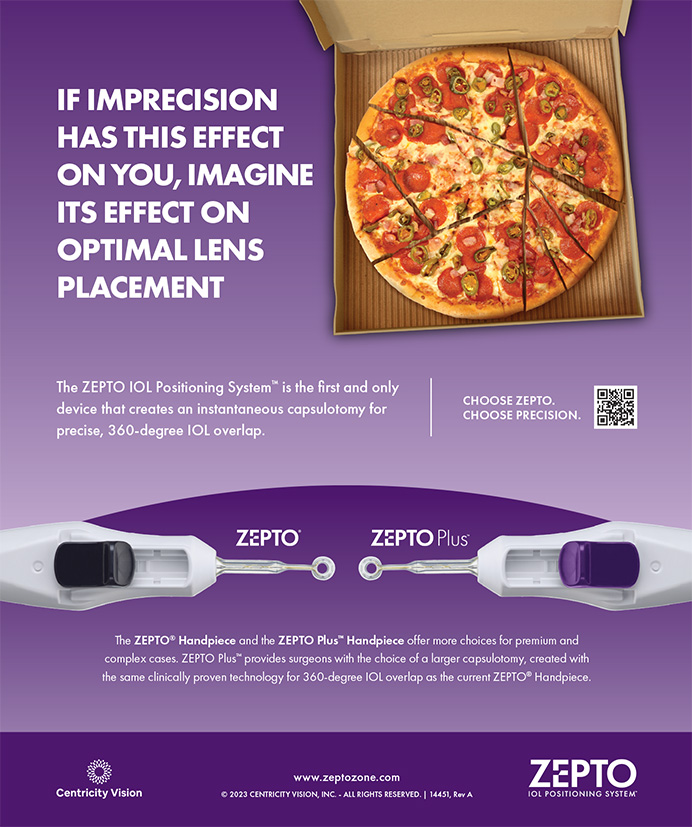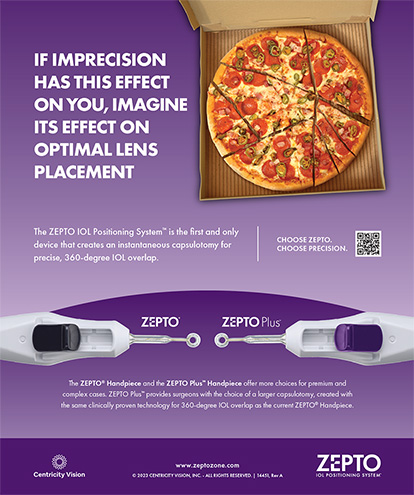A number of the causes of weakened zonules can present challenges during cataract surgery. These include trauma, congenital syndromes (eg, Marfan's, homocystinuria), chronic uveitis, retinitis pigmentosa, previous ocular surgery (glaucoma, retina), and pseudoexfoliation (PXF). The principles discussed in this article can be used or applied in any of these situations, but lax zonules most often occur in eyes with ocular trauma (often remote and therefore forgotten by the patient) and PXF syndrome.
PREOPERATIVE EXAMINATION
The management of zonular issues begins with the preoperative examination. In PXF, take note of the pupil's size, look for asymmetry in the chamber's depth, and check for subtle phacodonesis.1 If the patient has a history of trauma, look for iridodialysis, a tilted lens, and phacodonesis. Gonioscopy is helpful in identifying potential areas of concern.
In cases of PXF, you must first manage the pupil. My favorite device for this purpose is the Malyugin Ring (MicroSurgical Technology, Redmond, WA). If I notice zonular problems, I will frequently stain the capsule with trypan blue, which may help me to identify the capsular edges later.
PREPARING FOR SURGERY
When preparing to operate, always have at least one backup plan and keep instruments you might need readily available. For example, microinstruments that allow for intraocular manipulations can be highly useful.
When starting the capsulorhexis, look for wrinkling of the capsule, which suggests generalized zonulopathy. I prefer to make a 5.5-mm capsulorhexis. Hydrodissection is important, and viscodissection is helpful as well.2 The latter allows for the implantation of devices that will stabilize the capsule such as the Mackool Cataract Support System (Duckworth & Kent, Hertfordshire, England; distributed in the United States by FCI Ophthalmics, Inc., Marshfield Hills, MA) or an Ahmed Capsular Tension Segment (Morcher GmbH, Stuttgart, Germany; distributed in the United States by FCI Ophthalmics, Inc.). The segment provides great stabilization when I am using an iris hook. A capsular tension ring (CTR) can also be inserted to help steady the bag; I insert it as late as I can but as early as necessary.3 If needed, another option is a Cionni CTR (Morcher GmbH; distributed in the United States by FCI Ophthalmics, Inc.), which features eyelets that can be sutured to the sclera.
Use a low-flow, zonule-friendly phaco technique such as prechopping or vertical chopping. Because performing I/A around weak zonules remains challenging after the nucleus is removed, I usually use a bimanual technique. I/A is easier if you delay inserting a CTR until after removing the cortex, because the device expands the capsular bag 360° and sits in the fornix. The Ahmed Capsular Tension Segment and MacKool Cataract Support System are helpful for cortical removal. The 110° diameter of the former allows cortex to be stripped around it, and the latter provides a point source of support for cortical removal. Take care not to strip more zonules if you tear the capsular bag.
If the bag is still intact and either a CTR or a Cionni CTR is in place, then you may insert an IOL. Studies of the newer generations of IOL materials show that both silicone or acrylic are fine and biocompatible.4 When using a modified CTR, I prefer an ab externo approach5 and suture fixate the ring with 9–0 Prolene (Ethicon Inc., Somerville, NJ) or 10–0 polyester (Alcon Laboratories, Inc., Fort Worth, TX).
If the bag is not intact, then you must decide where to implant the lens. Modern ACIOLs work quite well in my experience, but I generally prefer to maintain a smaller incision6 and use iris fixation with an acrylic lens and place 10–0 Prolene sutures.
When choosing a CTR, I use a standard model in eyes with less than 90° of zonular dehiscence. For up to 180° of dehiscence, I use a modified Cionni CTR with one eyelet. For more extensive dehiscence, I use a Cionni CTR with two eyelets. When using the two-eyelet device, it is important to make sure that the eyelets are placed 180° apart to prevent decentration in the capsular bag.
CONCLUSION
Although loose zonules are a surgical challenge, there are many new devices and techniques that can convert an unstable anterior segment to a stable one, thereby reducing the need for vitreous surgery and other complications. A careful game plan with a backup strategy is necessary.
Alan S. Crandall, MD, is a professor, the senior vice chair of ophthalmology and visual sciences, and the director of glaucoma and cataract for the John A. Moran Eye Center at the University of Utah in Salt Lake City. He is a consultant to and a member of the speakers' bureau for Alcon Laboratories, Inc. Dr. Crandall may be reached at (801) 585-3071; alan.crandall@hsc.utah.edu.


